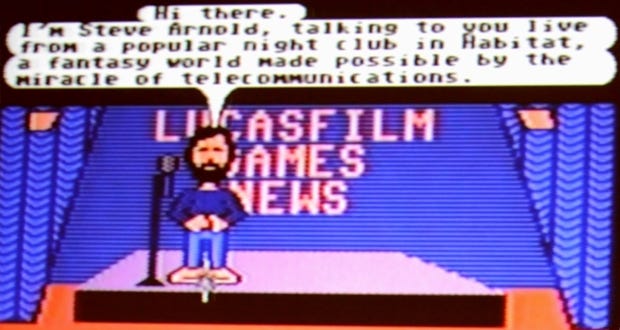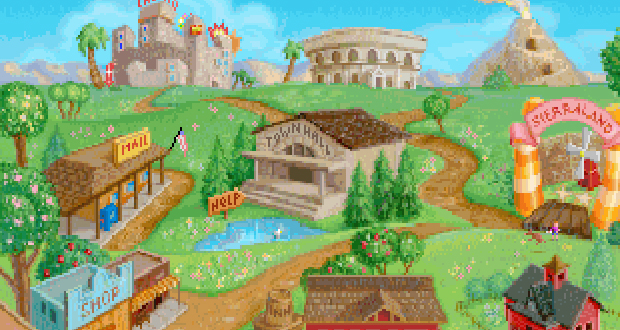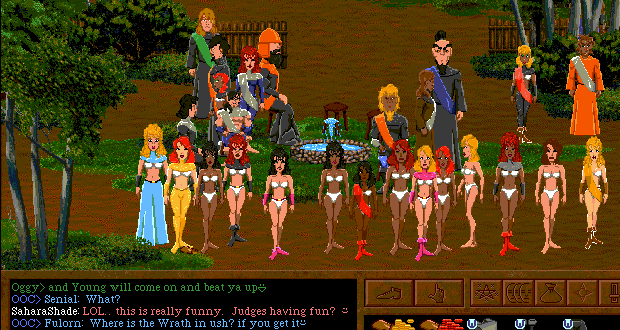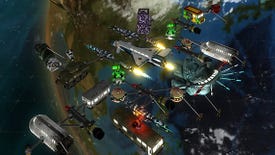The RPG Scrollbars: Old Habitats Die Hard
Digital archeology
There's no better way to cause trouble than to talk about 'firsts'. Say for instance that King's Quest IV featured the first female adventure character, and you're probably going to be drowned out by some pedant waving a copy of Infocom's Plundered Hearts in your face. That pedant may even be me. Of course, that's nothing compared to the folly of calling, say, Everquest the first MMO and leaving it without some very quick clarification. The extent of the first M in MMORPG, the importance of success over existence, the jump between mainframe and computer and all manner of other stuff makes it tricky to plant a flag everyone can actually agree deserves to be there.
But there aren't many games with a better claim than Lucasarts' Habitat, the latest classic game to get a fancy modern revival project. It definitely deserves it.
Habitat is arguably Lucasarts' most impressive bit of coding - a multi-participant virtual online environment originally built for the Commodore 64, in the space-year 1986. Not a typo. 1986. On the surface it was much like later, more famous chatrooms, and indeed it was bought by and used and upgraded by the company that made one of the most famous during the 90s, WorldsAway. However, even at this early stage, it was a complex beast, complete with avatars, weapons, in-game housing and a persistent world full of items and goodies to play with instead of simply empty locations. And player events, with the most famous being a devs vs player maze game where the devs got magic instakill guns. Unfortunately, one forgot their invulnerability flag, had their corpse looted, and so the fancy tool got into the wild. Even then, you can see the innocence of the era by the fact that the developers negotiated with the player for its return in virtual monies instead of just dropping the mighty banhammer.
Habitat is also interesting purely for its central concept - being an object orientated system that almost smacks of a human version of Creatures, where the focus was more on providing potential objects to play with rather than stock quests as such. The funniest of those items had to be the players' own heads, which apparently led to the stock way of griefing players. Persuade them to remove their head. Persuade them to hand over their head. So began the legend of the literal head-hunters.
This was so early that even post MOO and MUSH on mainframes, every lesson was being learned for the first time. Initially, any player could be killed and looted. Later, Habitat developed dedicated PvP zones, and would have had player operated justice if the developers had solved the issues in time. In another case, again from the 'innocent nascence of the genre file', players supposedly - and I'm going from Engadget's fantastic series written back in 2012 here - found a way of breaking the game economy, but were allowed to keep the money as long as they spent it on making the world a better place. And if the piece is anything to go by, they accepted, running treasure hunts and the like to spread the wealth.
Now, obviously you'll note that the second-hand nature of many of these stories. Habitat's not a game I ever played in its original format, due to three basic reasons - I live in the UK, I never owned a C64, and I was six when it came out. Still, I have a real fondness for these proto-MMOs simply because I remember the dreams and fantasies of that era when the concept of the internet was actual, literal magic rather than an essential service we all simply take for granted. I remember, many years before having my first modem and coming to live in fear of the phone-bill's arrival every three months, just poring over the magazines of the time and trying to imagine what it would be like to step into those worlds, like Meridian 59 and Everquest and Asheron's Call and Ultima Online. Having the modem didn't really help much though. Games were charged like other internet services, which is to say by the minute/hour, rather than the subscription fees we got used to, and in the UK, local calls weren't free. For the first few years I was online, the best you could hope for was a penny a minute connections in weekends.
There was exactly no chance I was playing these games at launch.
But I could certainly live vicariously through them. One of the biggest examples of that came courtesy of Sierra's InterAction magazine, which was frequently bundled with UK mags, and for a while at least delighted under the title 'A blatantly biased look at games from the Sierra family'. Sierra's offering was called The ImagiNation Network, and almost the exact opposite approach to Habitat. Habitat invited players to build their own world, Sierra just wanted them to play nice in theirs. Lucasarts encouraged players to find their own fun, Sierra populated its world with lots of pre-made games, from classic casino offerings to early RPGs like Shadow of Yserbius - Yserbius being Elvish for 'better RPGs'. Everquest these early games were not.
Still, just look at it. Look at how beautiful it was, especially for the time, and especially factoring in things like different palettes for the changing seasons. And think! If you played it, you too could meet people like this! For surprisingly little money!
Like Habitat, ImagiNation spawned a revival project, which you'll find here. If you're interested, I wrote it up in detail for a Crap Shoot column in Another Place some... Christ, more than six years ago. How time flies, turning even retro columns retro. Sierra would also launch a game that initially looked a lot like Habitat, although which ultimately would draw more inspiration from other MMOs - The Realm, a game which I confess I have few memories of save for an early beta that consisted entirely of walking around a forest built in an extended version of the SCI engine where you'd occasionally encounter a monster, but more usually a female character stripped to her bra and pants. I was about to say 'Of course, I'm sure that it became something very different', but then I looked for a screen and... well... got this. So. Yeah.
But back to Habitat. The revival project is one of the few that's actually in a good place, legally and technically. Lucasarts sold Habitat and it ended up with Fujitsu, whose people happily handed over permission to play, and the team has big chunks of the source-code. The full story can be read here, in a Paste article from 2016. As of this year however, the NeoHabitat Project is swinging into full action, with a call for Java engineers and other programmers, and progress including being able to connect to NeoHabitat with an actual C64. Unlike ImagiNation, there's still a long way to go before anyone steps back into the world, but at least it's progress. The team's homepage is here, with the plan being to re-build the whole system as an open source project. I know I'd love to see that. A slice of history not in fact gone when the servers were unplugged, but simply sleeping in conceptual stasis for a second chance.
It's just a shame how much does get lost forever, from the community to the sense of wonder that could only happen back in the early 80s and 90s when Clarke's Law was very much in effect, and sufficiently advanced technology really was indistinguishable from magic. And not just the kind with fireballs, awesome as that will always be.















